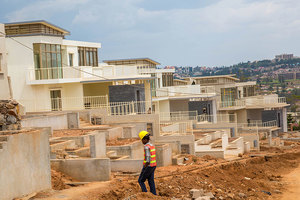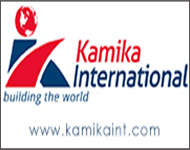 Emerging markets like Rwanda should become more innovative and embrace digitisation as one of the ways to open up and integrating their markets besides supporting investors to adapt to an uncertain business and investment environment, said Allan Gichuhi, the EY Rwanda (formerly Ernst & Young) partner.
Emerging markets like Rwanda should become more innovative and embrace digitisation as one of the ways to open up and integrating their markets besides supporting investors to adapt to an uncertain business and investment environment, said Allan Gichuhi, the EY Rwanda (formerly Ernst & Young) partner.
Commenting of the global audit and services firm’s 2017 African Attractiveness Investment report, Gichuhi said opportunities for growth and investment are a lot more uneven presently, which has affected foreign direct investment inflows among most developing nations. Business Times’ Peterson Tumwebaze caught with him to discuss the report and what is influencing FDI patterns in Africa amid growing global uncertainty.
Tell us about the recently launched African attractiveness investment tool.
This tool helps us to measure resilience in the face of current macroeconomic pressures, as well as progress in critical areas that support long-term development, including governance, diversification, infrastructure, business support and human development. For example, the EY African attractiveness investment 2017 measures the foreign direct investment (FDI) attractiveness of 46 African countries basing on six broad pillars that act as key determinants for choosing a location to invest.
What is the current trend in terms of FDIs to Africa presently?
Foreign direct investment patterns in Africa continue to hold steady despite growing global uncertainty. The key hub economies on the continent - South Africa, Nigeria, Kenya, Egypt and Morocco - remain Africa’s top recipients of FDI projects. The Asia-Pacific region has become a more visible FDI investor with China picking up pace in Africa amid uncertainty around US policies and Brexit. However, the US remains Africa’s leading investor, accounting for 13.5 per cent of inward investment projects. In 2016, companies from the US invested in 91 projects and created 11,430 jobs.
However, this was a drop of 5.2 per cent compared to the previous year. South Africa (28 projects) continues to be the key target of US-based companies, with Morocco (14 projects) and Egypt (13 projects) outpacing Kenya (11 projects) to become the second and third-largest recipients of US investment, respectively.
How can emerging markets like Rwanda do to attract more FDIs and boost growth?
Digital transformation can be a game-changer for inclusive growth. We are confident Africa’s growth will continue to improve, and growth prospects remain robust for long-term. Many countries will grow at 3 per cent or above per annum, with a big number of high-growth economies expanding by more than 5 per cent annually. Between 2001 and 2015, there were 14 such countries, and this number is expected to rise to 19 by 2030. However, it is important to understand that Africa’s uneven FDI picture reflects the current global uncertainty.
Remember, the global political, economic and investment landscape has entered a period of transition. Some of the factors contributing to investor uncertainty include the UK vote to leave the European Union (EU), the election of Donald Trump as the US president, and China’s entry into a new phase of slower economic growth. More still, with the ongoing ‘Fourth Industrial Revolution’ and technologies such as the ‘Internet of things’ set to disrupt existing business models and create new ones, the global cross-border investment landscape is poised for big change.
In addition, despite a drop of three places in the current attractiveness report, Rwanda has Africa’s second-best business environment, according to the World Bank’s Ease of Doing Business Index 2017. The country is doing very well on the front of macroeconomic resilience, business enablement, investment in infrastructure and logistics and economic diversification, among others.
What are some of the FDI pull factors into Africa and which sectors are attracting most of these investments?
During 2016, capital investment into Africa rose by 31.9 per cent and investment per project averaged $139 million, against $92.5 million in 2015. This surge was driven by several large capital intensive projects in the real estate, hospitality and construction, transport and logistics sectors.
The continent’s share of global FDI capital flows increased to 11.4 per cent, up from 9.4 per cent in 2015, making Africa the second-fastest growing destination when measured by FDI capital. This somewhat mixed picture (of FDI inflows) is not surprising to us. We believe that investor sentiment toward Africa is likely to remain somewhat softer over the next few years.
From our point of view, this has far less to do with Africa’s fundamentals than it does with a world characterised by heightened geopolitical uncertainty and greater risk aversion. Companies that are already doing business in Africa will continue to invest, but could exercise a greater degree of caution. We think that any shorter-term shifts in FDI levels will be cyclical rather than structural. We also anticipate that the evolution of FDI - increasing diversification in terms of sources, destinations and sectors - will continue. Over the longer term, as economic recovery slowly gathers pace and as many African economies continue to mature, we also anticipate that levels of FDI will remain robust and continue to grow.
Do we see efforts to fast-track regional integration attracting FDIs into the region?
We already see more FDI inflows to the hub economies like Rwanda with new clusters emerging in East and West Africa. Over the past year, foreign investors tended to move toward the larger and more diverse economies in Africa. These include South Africa, Morocco, Egypt, Nigeria and Kenya. Collectively, these markets attracted 58 per cent of the continent’s total FDI projects in 2016. Given that these markets are the dominant anchor economies in their respective regions, they provide investors with greater scale and relatively more mature markets. While foreign investors still favour the key hub economies in Africa, a new set of FDI destinations are emerging, with some of the Francophone and East African markets of presenting a particular interest. For example, Kenya, Tanzania, Uganda, Rwanda and Ethiopia remained among the fastest growing on the continent last year despite year-on-year declines in FDI flows into the region.
African markets generally, including Rwanda, Tanzania and Uganda are highly placed in terms of FDI attractiveness, according to our study and we are optimistic that the trend will continue.
Recent oil and gas discoveries in the region have put them even more firmly on the investor map, although Tanzania has also benefited from strong growth over the last decade, driven by increased investment in infrastructure and services.
What about intra -Africa investments to attract more investments?
After hitting an all-time high in 2013, the share of intraregional investors in FDI projects has continued to ease. It stood at 15.5 per cent in 2016, down from 18.9 per cent in 2015. This is the weakest growth rate registered across sub-Saharan Africa in nearly two decades.
Latest estimates indicate that sub-Saharan Africa’s growth was only 1.4 per cent in 2016, with two of the three largest economies - Angola and Nigeria - in recession, and South Africa only growing marginally. South Africa outpaced Kenya as the continent’s largest intra-regional investor because of a sharp decline in Kenya’s outbound FDI projects in 2016, from 36 to 14. Investors from Morocco also became more prominent last year, initiating 17 intra-regional investments, the highest in over a decade.
In 2016, the broadening of Greenfield FDI projects in Africa beyond the extractive sectors held momentum. For example, consumer oriented sectors again attracted the bulk of FDI, with coal, oil and natural gas, and mining and metals collectively accounting for just 6.2 per cent of FDI projects during the year.
Investment in the African financial services sector however slowed, with FDI projects down 43.2 per cent compared to 2015. The number of jobs created and capital investment also declined.
Looking forward, what is the future like for the continent?
Our analysis of 2016 economic and FDI data reaffirms the view we expressed in last year’s report: despite a slowdown in overall economic growth and a variable, “multispeed” picture across Africa, most of the economies on the continent remain resilient, and the long-term outlook is positive.
Our view remains that Africa’s rise over the past 15 years is real. It is important to note that what we have witnessed has been a process of structural evolution rather than the kind of cyclical change that has marked previous boom and bust periods in Africa’s post-colonial history.
Although exports from many African economies remain commodity-orientated, private consumption has become a key growth driver as has investment in infrastructure. The services sector is increasingly becoming a significant grow driver in most African economies and, while still small, the role of (and investment into) manufacturing is also increasing. These multiple factors underpin the resilience displayed by many African economies in what have been extremely challenging global conditions over the past few years.
Though the process of structural evolution will likely take decades as has been the case elsewhere, most African economies are in a fundamentally better place today than they were 15 to 20 years ago. Besides, overall growth is projected to remain robust compared to other regions over the next decade. Structural evolution will continue, and as economic conditions improve globally, and many African nations will be well-positioned to accelerate the growth momentum once again. This will, however, require an emphasis on a proactive and action-orientated approach that is tailored to support emerging and future trends.
Going forward, a best case scenario for Africa will be one that leads toward an inclusive and sustainable growth path, driven by the continent’s ability to connect markets and polities within and beyond.
The emerging digital technologies will be a critical catalyst in this regard, as well as the collaboration between the public and private sectors that is required to encourage and harness inclusive growth and help create the conditions and institutions to capture the potential demographic dividend.
Posted on : 29 Jun,2017
 Emerging markets like Rwanda should become more innovative and embrace digitisation as one of the ways to open up and integrating their markets besides supporting investors to adapt to an uncertain business and investment environment, said Allan Gichuhi, the EY Rwanda (formerly Ernst & Young) partner.
Emerging markets like Rwanda should become more innovative and embrace digitisation as one of the ways to open up and integrating their markets besides supporting investors to adapt to an uncertain business and investment environment, said Allan Gichuhi, the EY Rwanda (formerly Ernst & Young) partner.




















